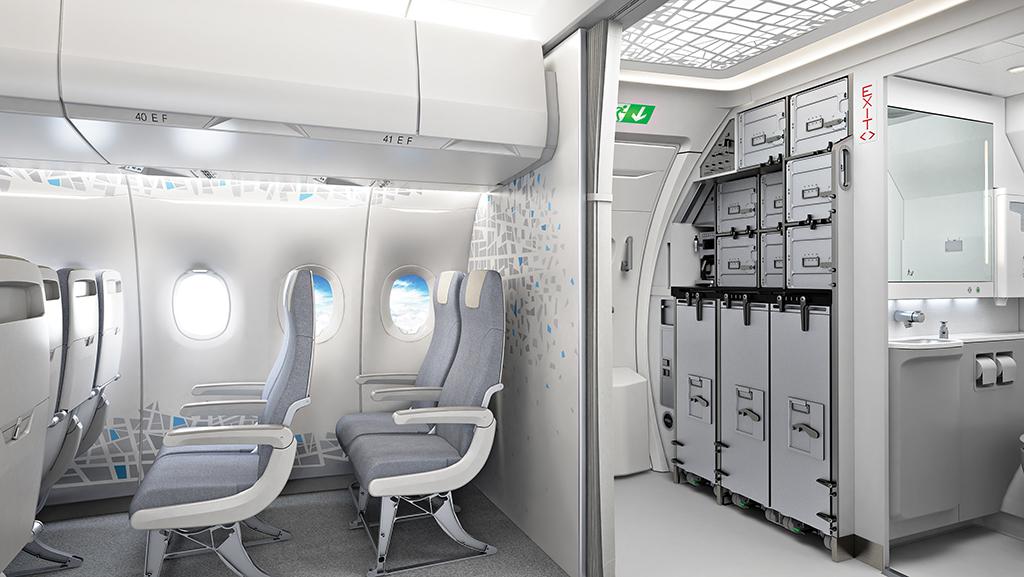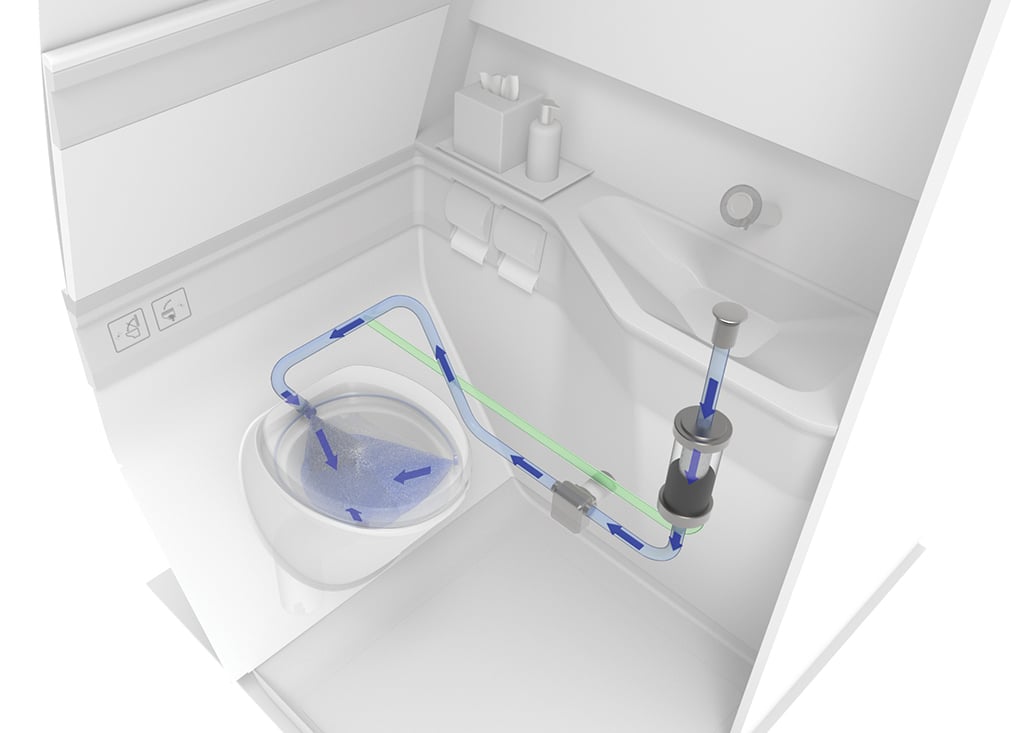Cabin Weight And Waste Cuts Help Sustainability Drive

An optimized cabin layout leaves room for more passengers.
For airlines under growing pressure to cut carbon dioxide emissions as part of long-term industry climate goals, changing cabin infrastructure and service can be an important contribution.
In Europe, Spanish airline Iberia, part of International Airlines Group, is addressing ways to make the cabin more environmentally friendly through both the “soft” products that are part of its cabin service—such as cushions, blankets, cups and newspapers—and hard products such as seats.
- Iberia sees 200-ton reduction in plastic onboard this year
- Diehl focuses on weight reductions through new materials, configurations and more
- Southwest Airlines and partners have upcycled leather seat coverings
“Weight is the thing we can really quantify,” says Melanie Berry, customer experience director at Iberia. “We’re always working with our suppliers on the lightest-weight solutions. We focus on weight in everything from a hard equipment point of view.”
The airline’s new Airbus A350s include lightweight seats made by Recaro Aircraft Seating that help the aircraft’s overall environmental profile. Iberia has ordered 20 A350s; four are in operation, and it is due to receive four more by the first quarter of next year. The airline is assessing which other aircraft to prioritize for cabin upgrades to help improve its environmental footprint.
More broadly, Iberia has been focusing on tailoring the amount of water carried on flights to minimize waste. “On the new A350, the water in the toilets only runs for 5 sec., whereas in the rest of the fleet it runs for 10 sec. Now we’re going to work on changing the rest of the fleet to use less water,” Berry says.

Making better use of the water is an area of focus for cabin equipment specialist Diehl Aviation, too. Its Greywater Reuse System collects used water from the sink in the onboard lavatory, treats it and then uses it to flush the toilet, allowing the aircraft to carry less fresh water. The weight reduction on a long-haul aircraft such as a Boeing 787 could amount to around 210 kg (460 lb.), Diehl says, reducing the aircraft’s CO2 emissions by almost 90 tons over a year. The Greywater Reuse System is being tested in flight now on Boeing’s ecoDemonstrator.
“To achieve aviation’s ambitious climate protection goals, literally every gram counts,” says Guido Van Geenen, Diehl Aviation vice president of corporate communications. “That’s why we’re researching ways to reduce system components in the aircraft as well and thus save weight. One example is the water tanks. While long-haul aircraft have so far been equipped with two or three tanks for fresh and wastewater, Diehl will offer a single-tank solution in the future. This alone can save up to 50 kg in weight in aircraft such as the A350.”
Diehl says it focuses on weight reduction starting with the product development stage and applies that across different cabin areas.
For example, in single-aisle aircraft, the latest air outlets made from particle foam reduce weight by around 11 kg, Diehl notes. Its air outlets made of foam granules and air ducts made of particle foam generate less CO2 during production and reduce fuel consumption due to their low weight, not to mention being quick and less expensive to produce and easier to recycle.
The German company also focuses on decreasing the space needed for cabin equipment, thus allowing more room for seats—its space-saving, weight-reducing galley and toilet combination creates space for an additional 12 passengers.
It is not just about the hardware for airlines, Berry says. Even seemingly tiny details can make a difference: On the A350, Iberia has opted to remove all headrest covers and their Velcro attachments, leaving just a wipe-clean surface.
“Every single detail we look at and try to make the most sustainable choices,” Berry says. “Meeting customers’ expectations as well is the challenge.”
Iberia has been working on limiting plastic in the cabin, too. This year alone, the carrier expects the reduction in plastics on board will reach 200 tons through initiatives such as replacing cutlery, stirrers and plastic straws with bamboo or paper alternatives; wrapping blankets with a cardboard band instead of plastic; and eliminating plastic wrapping for earplugs and some toiletry bag items.
The airline also plans this year to replace plastic cups and some food wrappers with more sustainable alternatives. In 2022, it recycled 43% of cabin waste using compartmentalized carts, including the selective collection of glass used on board—last year, 62 tons of glass were recycled at its catering provider’s Madrid facilities.
Berry says the airline has to strike a balance when it comes to making greener choices on board. Newspapers and magazines have been replaced with digital versions, but Iberia has not opted to replace paper menus, even though digital ones are available. “How we manage the physical and the digital is a fine balance,” she notes. “Customers want to be sustainable, and they expect us to have sustainability initiatives. But not everyone is digital. Digital is a great enabler, but we have to also keep some of the physical things for the customers that don’t have digital tools.”
Meanwhile, the debate over what approach is the most sustainable continues in some areas. “For meal equipment, there is a bit of an unknown as to whether disposable equipment is more sustainable than rotable. There are pros and cons,” Berry says.
Disposable waste needs to be incinerated, but reusable cutlery and dishes need to be washed, using water and chemicals. Airlines are hoping for more clarity on rules about incineration of disposable waste such as cardboard trays. “There’s an important conversation happening within the industry. We’re all waiting for legislation around disposal of international waste and a scientific answer about what truly is sustainable in terms of meal equipment,” Berry says.
For now, Iberia’s meal tray lids are made from recycled plastic, and passengers can buy a discounted coffee if they bring their own cup.
Cutting food waste also plays a role, Berry says. “We are hoping in the summer to launch preselection [of meals] for our customers in business class initially. The plan is to eventually roll it out to economy. It will give them the option to preselect what they want, and we’re also going to include an option to opt out. That will definitely help with food waste.
“We’re on a journey. We started the journey just before COVID, and we implemented quite a lot, but it’s a never-ending journey,” she adds.
Cabin sustainability efforts for airlines in the Americas include initiatives to cut waste and implement fuel-saving weight reductions.
In environmental, social and corporate governance (ESG) reporting for the full year of 2022, Southwest Airlines reports saving 6 million gal. of fuel through onboard weight reduction efforts that include cabin interior retrofits. It also has partnered with organizations to upcycle thousands of pounds of leather seat coverings (made from 57% recycled leather waste), keeping the material out of landfills. Similarly, United Airlines in 2022 upcycled material from more than 700 seat bottoms, approximately 900 seat backs and over 1,000 headrests, conserving 3.4 million gal. of water and resulting in nearly 813 lb. of landfill avoidance, the carrier says. The material, coming from first-class cabins on Boeing 757 retrofits, was used to create backpacks, duffel bags and tote bags.
Delta Air Lines also touts recycling efforts, including the elimination of approximately 4.9 million lb. of single-use plastics in 2022 and utilizing sustainable options like bamboo cutlery and canned beverages.
American Airlines is focusing on reducing fuel consumption as well with lighter seats and new brakes, saving an estimated annual 6.9 million gal. of fuel and 2.8 million gal. of fuel, respectively. It also stocks its galleys with only as much ice as passengers are expected to use on each flight and uses lighter paint, which saves about 1 million gal. of fuel per year on its Airbus A321 fleet alone, the carrier says. Collectively, it reports weight-reduction efforts save 12.4 million gal. of fuel annually, which equals 117,800 million tons of CO2 emissions avoided each year.
For Santiago, Chile-based LATAM Airlines Group, cabin sustainability efforts include a goal announced in June 2022 to eliminate 100% of single-use plastics in its operations by 2023. Last year, the company launched new travel kits in its premium business cabins that feature more sustainable elements including bamboo toothbrushes. In economy class, the airline said it would replace materials used for all elements of service with reusable or recyclable materials. At the time, LATAM explained that in the short term the initiative would eliminate more than 1,000 tons of single-use plastics, equivalent to 36,000 500-ml (16.9-oz.) plastic bottles.
Canada’s flag carrier is working to reduce single-use plastics, too, and participates in various activities to mitigate onboard waste, including programs that allow it to repurpose, recycle or reuse used and surplus uniforms. Air Canada’s unused amenity kits are collected and sent to those in need through charitable organizations, and gently used duvets, blankets and mattress pads from the cabin are dry-cleaned and distributed to local charities.
The airline also has recycling processes at its six Canadian hubs to recycle newspapers, magazines, plastic bottles, aluminum cans and other beverage containers used on domestic flights.








Comments